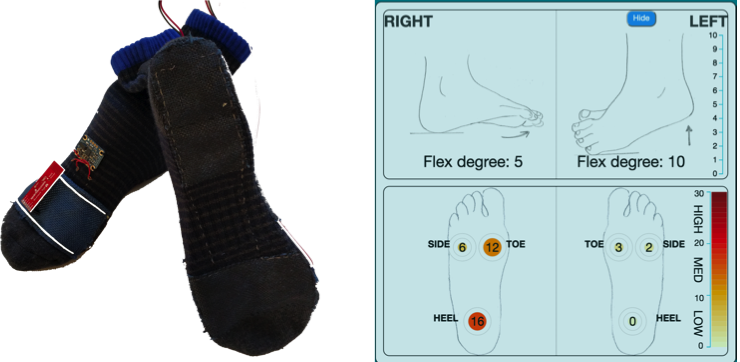Supporting Bodily Communication in Video Consultations of Physiotherapy
Physiotherapists assess, diagnose and treat people with movement problems. Their assessment and diagnosis relies on close observations and hands-on work with patients to detect subtle differences in body movement, e.g., lack of balance in squats, abnormal distribution of weight on the affected foot, or limitations in range of movement for different joints. These treatments are typically based on exercises and education to help patients improve their movements and resume their normal lifestyle.
Increasingly, physiotherapists are starting to use video conferencing tools to conduct consultations over a distance. Such consultations are referred to as video consultations. Since in video consultations, patients and physiotherapists are available at two remote ends, this research is motivated to understand how do physiotherapists assess and treat patients during video consultations; And how can interactive technologies enhance the capabilities of physiotherapists to make video consultations effective?
To start with, I investigated the current practises of video consultations in order to understand the challenges faced by physiotherapists in assessing patients over video. This study involved observations of 10 naturally occurring face-to-face and video consultations of physiotherapy at Royal Children’s Hospital, Melbourne.The study highlighted the need to design a technology that can offer better understanding of the subtleties related to lower body movements to physiotherapists, as these are more challenging to observe over video.
To support lower limb assessment over video, I have designed a wearable technology called SoPhy. SoPhy captures and presents information related to weight distribution, foot orientation and range of movement. SoPhy consists of two parts: (1) a pair of socks with embedded sensors for patients to wear, and (2) a web interface that presents the captured information to physiotherapists in real-time. Laboratory evaluation of SoPhy showed that SoPhy increased the confidence of physiotherapists in assessing squats exercise and fewer repetitions were required to assess patients when using SoPhy.
Finally, I investigated the use of SoPhy in video consultations, organised by physiotherapists for their patients at the Royal Children’s Hospital. SoPhy quickly became a part of the clinical practise of physiotherapists with significant benefits to patients in making the therapy goals intuitive and easier to achieve. As such, it was appreciated as a valuable tool in both assessing and treating patients having weight bearing issues.
Here are the slides of my PhD completion seminar:
Project Highlights - Media Coverage
My PhD work on SoPhy smart socks has received coverage in over 200 media outlets (including radio, TV news, newspapers and magazines) in Australia and overseas, with a combined coverage of over 86 million people. The story was covered overseas in the United Kingdom, United States, India, Malaysia, Israel, Italy, New Zealand, Iran, Canada and China.
Key highlights include video coverage by BBC news, Ten News, ABC News, and 7 News; live interview on Channel 9 Today Show, and Pulse Radio morning show; a cover story by The Indian Weekly, and selection in the London Science Museum (From the Lab video series). Some of the media stories are listed below.
- London Science Museum, 20 June 2018. How smart socks revolutionise physiotherapy (part of 'From the Lab video series').
- Tenplay Scope TV, 17 June 2018. Smart socks.(from 17.30 min to 19.55min)
- Radio Mirchi, 7th June 2018. Smart Socks (Hindi interview).
- BBC News, 16 May 2018. Smart SoPhy socks send data to your physiotherapist.
- Pulse Radio, 7 May 2018. ‘Smart socks’ offer hope for remote patients with chronic pain (Live Interview).
- The Indian Weekly, 19 April 2018. Smart Solution (Cover story).
- Pursuit, 9 April 2018. Clever socks connecting remote patients and physios.
- SBS, 11 April 2018. Indian-Australian invents ‘smart socks’ for chronic pain sufferers.
- Channel 9 Today Show, 10 April 2018. Smart Socks (Live Interview).
- New Atlas, 10 April 2018. Smart socks designed to aid physio-by-Skype.
- Cosmos, 10 April 2018. Young inventor puts a sock in it.
- Ten News, 9 April 2018. Big Step.
- ABC News, 9 April 2018. 'Smart socks' offer hope for remote patients with chronic pain, researcher says.
- 7 News, 9 April 2018. Vic student creates physio 'smart socks'.
- Ten Play, 9 April 2018. Wearable technology improves treatment opportunities for rural and remote patients.
- XinhuaNet, 9 April 2018. Remote physiotherapy possible in Australia with "smart socks".
- Starts at 60, 9 April 2018. ‘Smart socks’ to help physiotherapists treat pain.
- TVNZ, 9 April 2018. Australian student using 'smart socks' to allow remote treatment by a physiotherapist.
- News.com.au, 9 April 2018. Vic student creates physio 'smart socks'.
- News Mail, 9 April 2018. Could these socks save your life?
- Katherine Times, 9 April 2018. Smart socks help remote patients.
- Perth Now, 9 April 2018. Vic student creates physio 'smart socks'.

